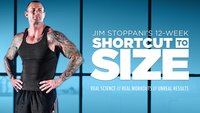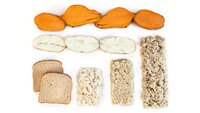
Carbohydrate Calculator: How Many Grams of Carbs Should You Eat?
Carbohydrates are great for building muscle and burning fat if you know how many to eat! This calculator will help you know how many carbs per day to eat for your goals.
Carbohydrates are the energy source your body relies on most throughout the day. They fuel your workouts and provide energy for movement and brain function. The calculator on this page provides recommendations for a moderate-carbohydrate diet, with slightly lower carb levels for fat loss and higher levels for muscle gains.
If you're new to tracking your macros, use the calculator's recommendations to get a good starting baseline. If you're transitioning from a so-called "standard American diet" with soda and crunchy snacks, this might already be lower than you're used to! Then, if you decide you want to try a lower-carb or ketogenic approach, you can experiment with reducing your carb levels.
Carbohydrate Intake Calculator
This daily carbohydrate target can help you lose weight in the form of body fat while minimizing muscle loss. Here are the next steps on your weight -loss journey:
1. Pick a weight-loss workout plan.
A well-designed program is an essential part of turning hard numbers into hard-body results! Here are the most popular ones from BodyFit:
2. Calculate your macros.
Carbohydrates are just one of the three macronutrients. To get targets for the other two, as well as a daily calorie target, use the Bodybuilding.com Macronutrient Calculator.
3. Learn about the best fat-loss supplements.
Supplements can help you accelerate your results once you have your carbohydrate intake and training in place. Krissy Kendall, Ph.D., shares her recommendations in the article, "5 Ways to Up Your Fat-Loss Supplement Game."
4. Join a fitness community.
For over 10 years, members of BodySpace have been helping each other build their best bodies. Join the world's strongest fitness community!
This daily carbohydrate target can help you focus on body recomposition, or gradually burning fat and building muscle, while focusing on your health. Here are the next steps on your journey to customize your nutrition:
1. Pick a workout plan.
A well-designed program is an essential part of staying motivated and seeing results. Here are some of our most popular programs from BodyFit:
2. Calculate your macros.
Carbohydrates are just one of the three macronutrients. To get targets for the other two, as well as a daily calorie target, use the Bodybuilding.com Macronutrient Calculator.
3. Learn about the best health-focused supplements.
Supplements can help you accelerate your results and support your training once you have your carbohydrate target and training in place. Chris Lockwood, Ph.D., shares what to take and why in the article, "Start Here: The Most Important Supplements for Every Body."
4. Join a fitness community.
For over 10 years, members of BodySpace have been helping each other build their best bodies. Join the world's strongest fitness community!
This daily carbohydrate target can help you build lean muscle mass while minimizing body-fat gains. Here are the next steps on your journey to see the scale go up:
1. Pick a muscle-building workout plan.
A well-designed program is an essential part of turning hard numbers like calories into hard-body results! Here are the most popular ones from BodyFit:
2. Calculate your macros.
Carbohydrates are just one of the three macronutrients. To get targets for the other two, as well as a daily calorie target, use the Bodybuilding.com Macronutrient Calculator.
3. Learn about the best supplements for gaining muscle.
Supplements can help you accelerate your muscle-building results once you have your carbohydrate intake and training dialed in. Krissy Kendall, Ph.D., shares her recommendations in the article, "8 Proven Supplements for Muscle Growth and Strength."
4. Join a fitness community.
For over 10 years, members of BodySpace have been helping each other build their best bodies. Join the world's strongest fitness community!
MAINTAIN CURRENT WEIGHT
First time tracking macros? Or not sure which goal is right for you? Then start with "maintenance." In theory, this is an amount of carbs in line with the number of calories that you burn to maintain your current weight. Many nutritionists say before you start cutting or adding calories or tweaking your macros, you should spend some time at maintenance level and get more comfortable with tracking your foods and portion sizes.
LOSE WEIGHT
If you know that you're ready to lose a few pounds and you have some experience counting calories or tracking macros, select "lose weight." This will give you a carbohydrate target in line with 200-700 calories below maintenance, depending on your activity level, and a 40/40/20 macronutrient breakdown of carbs, protein, and fats. This is a popular "sweet spot," both calorically and in terms of macronutrients, for healthy, sustainable weight loss.
GAIN WEIGHT
Gaining weight—especially as muscle—sounds easy enough. Train hard, eat big, right? But once the fork hits the plate, plenty of people find they need to eat far more than they realized to see the scale move up. Selecting "gain weight" will give you an amount of carbs in line with 500 calories above maintenance, on a 40/30/30 macro split. If this doesn't make the scale go up after a couple of weeks, you may need to add a few hundred more calories.
ACTIVITY LEVEL
This choice should reflect the amount of activity in your life based on how you exercise and how physically active your life and/or job is. Nutritional researchers agree that calorie estimates should take more into account than just the amount you exercise. Here's how to figure out what's right for you:
- Sedentary: You work at a desk job and you don't do much housework, walking, or exercising.
- Lightly active: You don't exercise much, but you go for walks 1-3 times per week and are on your feet doing housework during some of the day.
- Moderately active: You exercise 3-5 times a week and stay moving throughout the day with non-exercise activities.
- Very active: You exercise intensely or play vigorous sports on most days.
- Extra active: You exercise intensely or play vigorous sports nearly every day, including occasional "two a days." You also work a physical job or are on your feet most of the time.
How Do I Determine the Carbs in My Food?
You can do this using food labels, as well as by weighing out your food on a food scale and using one of the many online nutritional databases.
Weighing food may seem like a lot of counting and not much fun, but it gets easier over time. Fitness coach Vince Del Monte says in the article, "From Here to Macros: 4 Steps to Better Nutrition" that you quickly learn to "eyeball" quantities of both calories and macronutrients after just a few weeks of practice.
Bodybuilding.com has also created visual guides to help you learn these skills:
Are Carbs Bad for Me?
No! Carbohydrates get a bad rap because when eaten in excess, they may add adipose tissue, aka fat. You'll notice that the calculator recommends lower carb levels for fat loss and higher for muscle gains. But if incorporated into a diet in the right levels and at the right times, carbs can provide all of the benefits with none of the cost.
According to registered dietician Paul Salter, the best times to eat carbs are before, during, and after workouts, so they can supply you with energy and replenish the glycogen you expend during long training sessions.
Another great time to carb up? Dinnertime. Many people think you shouldn't eat carbs at night if you want to stay lean, but this is a myth. Not only will carbs after dark not hurt you, but eating most of your carbohydrates in the evening can actually help you lose fat and optimize your hormones.
What Are the Best Types of Carbs for Losing Weight and Building Muscle?
For the most part, it's best to opt for complex carbs from whole foods to fuel your day. These foods break down more slowly and provide sustained energy instead of spikes and crashes. Great sources of complex carbs include sweet potatoes, brown rice, fruit, and starchy veggies like peas and carrots, which all have plenty of fiber to slow down their digestion. These foods also have more of their micronutrients intact compared to processed foods.
But there's a time and a place for simple carbs, too. Even so-called "bad carbs" like certain types of candy, aren't always bad. When you eat them during training or right after exercise, they can help restore your muscle glycogen more quickly and start your recovery sooner. In other words, the sugar goes straight to your muscles to help you heal up from your last workout and prime you for your next one.
Protein and carbs are the perfect post-workout combo to support hard training and help you nail your goals. - View All
GET SYSTEMATIC ABOUT YOUR RESULTS
Once you have your daily carb intake, it's time to take the same kind of strategic approach to the rest of your training and nutrition. These popular calculators can help you dial in your plan!














